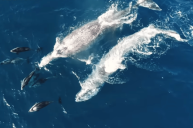As if dolphins weren't smart enough already. Now, these marine mammals are showing us that they can make human vowel sounds. That's right you heard that correctly. Dolphins are capable of producing human vowel sounds. This discovery comes shortly after Google released its new AI model, DolphinGemma. Which People Magazine shared "is set to revolutionize dolphin communication." With all of this new information and technology emerging, scientists now believe we may be able to communicate with dolphins using this new AI-powered dolphin translator.
Will We Be Able To Communicate With Dolphins?

Shutterstock Image
I don't know about you, but at least once in my life I fantasized about talking to animals. As far as animals go, dolphins would be a pretty incredible one to talk to. Not only are they wicked smart and cute as a button, but they have seen places in the oceans that most of us could only dream of. Apparently my dream of porpoise communication is not as far-fetched as it sounds.
A new study revealed that dolphins are already familiar with certain aspects of human communication — specifically certain vowels. The study highlights how dolphins have developed the ability to produce specific sounds. Additionally it states that those sounds "mimic vocalizations resembling the human vowel sounds A, E, O, and U."
But how? Well unlike humans, dolphins do not communicate using their mouths. Instead, they communicate with their blow holes and air sacs. This allows the to create a wider range of octaves when communicating.
How The AI-Powered Dolphin Translator Comes Into Play
Lead researcher Jack Kassewitz, from SpeakDolphin, shared that he has full confidence in dolphin's ability to communicate with humans. His belief mainly stems from working with one talented dolphin named Zeus. He said, "I am convinced that some dolphins, Zeus in particular, are as determined to communicate with us as we are with them."
From there he explained how dolphins communicate differently when speaking to one another vs. with a human. He argued that when dolphins vocalize above the surface it is "almost certainly to get the attention of nearby humans." Additionally, he mentions how when Zeus made the vowel sounds he did so with "his head above water and directed at our research team." He argued that that showed Zeus was intentional with his efforts.
These incredible interactions came just one week after Google released a progress update on its AI-powered dolphin translator. People Magazine shares that "The AI model uses the SoundStream tokenizer, a Google audio technology, to recreate dolphin sounds to identify recurring sound patterns, clusters, and reliable sequences."
Additionally, researchers created the Cetacean Hearing Augmentation Telemetry (or CHAT). This system creates "synthetic dolphin sounds and then associates those sounds with objects that the dolphins they're [meaning researchers] are studying enjoy." CHAT then listens to see if dolphins will mimic the sounds that it creates. If they do, then the researcher knows which sound correlates with which object. Thus allowing researchers to understand dolphin's needs and respond to their requests.
So while you won't hear a dolphin uttering full sentences any time soon, this AI-powered dolphin translator is seriously stepping up the way that we communicate with dolphins.




